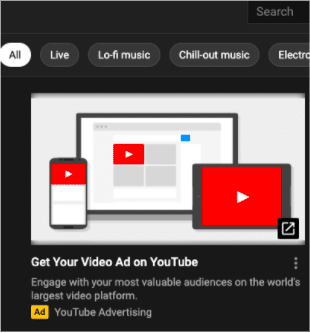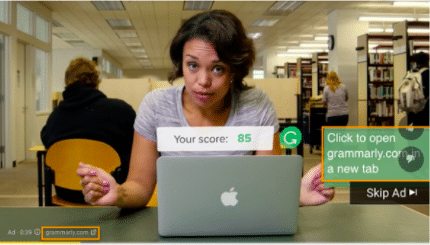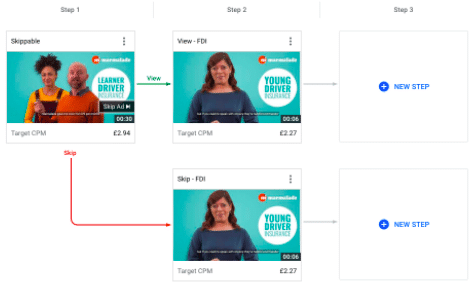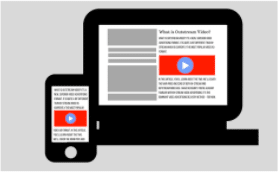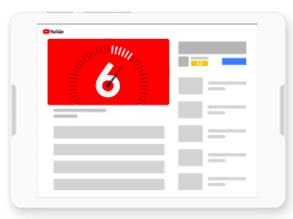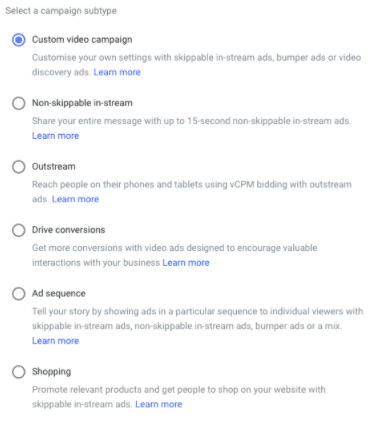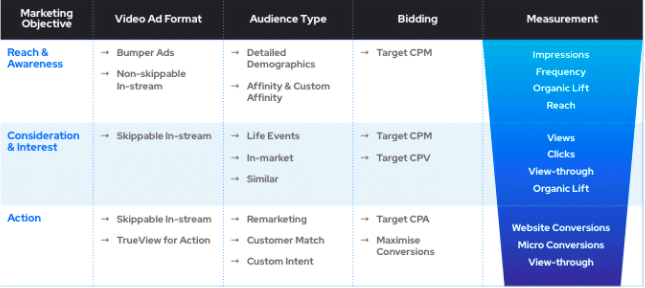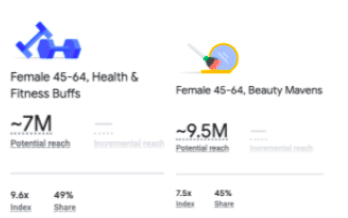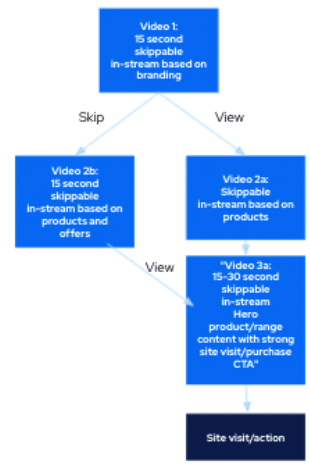YouTube – where do we start? According to Google, the average adult watches more than 40 minutes of YouTube a day, and overall there are 2 billion users on the YouTube platform. Some pretty hefty user stats, so how do we reach them? What videos do we use, what bidding strategies, what audiences and where? I’ll be taking you through all the above, and more!
In this blog post I will discuss
- Intro to ad formats
- Multi-tiered YouTube Strategy set up.
- Measurement and reporting
So feel free to skip to the most relevant section!
I’ve assumed a basic knowledge of PPC and the Google Ads UI in this article, and so the things I don’t cover in this article are the more granular optimisations you can make in YouTube, such as applying demographic/location targeting, negative placements/topics (like keywords) and excluding the undesired labels (eg. Mature audiences), as well as the basics of how to set up a campaign from scratch. Though if you’ve ever run Display or Search, then it’s an identical process that goes for YouTube, too.
Table of Contents
Intro to ad formats
Great, first, let’s talk about the different ad formats we can use.
Trueview ads.
These are the standard YouTube ads that we will be using most in our strategies. Advertisers only pay when a user watches the ad for at least 30 seconds or until the end of the video or if the viewer takes an action, such as clicking on a call-to-action.
These come as skippable ads of 12 seconds to 6 minutes long, or non-skippable 15-20 seconds.
- Trueview Discovery. This ad unit consists of an image thumbnail and up to three lines of text. Clicking the ad will deliver a user to the YouTube watch or channel page to view the video rather than playing the video within the ad unit itself.
They appear on the YouTube Homepage, Search Results pages and Related Videos.
- Trueview In Stream. These are your skippables and non-skippables. These include TrueView for Action ads which allow us to put CTAs and Sitelinks against the ad. These will be our main focus in YouTube campaigns.
They appear before, during or after watching a video.
- Trueview Shopping. These appear as skippable in-stream ads, and allow up to 6 product cards to appear alongside the video. We’ll need to connect Merchant Centre for this, and we can then filter our products (in the same way as we’d do in Shopping! ie. custom labels, product type etc. to ensure we’re showing the ads most relevant to our product.)
- Trueview Sequence. These are up to 5 ads in a 3-tiered sequence, in order to tell a story depending on whether a viewer saw (an impression), viewed, or skipped the video.
Pre-roll ads.
These are 6 second bumper ads that appear before the video. They often complement larger video campaigns, such as showing this ad as the second ad in a sequence.
Outstream ads.
These are Mobile and Tablet ads that show on partner sites and are only available on mobile and tablet devices. These make it easier for users to tap to play your video. Outstream ads can help increase brand awareness by extending your reach beyond YouTube.
Now, when you navigate to Google ads to set up a new campaign, when presented with the following flurry of options, you should have a little more idea as to what is actually going on.
Intro to YouTube Strategy
Basic YouTube strategy can be summarised within one handy table, which is here. I’ll go into section in more detail below:
-
Reach and Awareness:
- Video Ad Format
- 6 second Bumper ads and 15 second non-skippable ads.
- At this stage of the funnel, cold users will be likely to skip any content put in front of them if given the opportunity. For this reason, unskippable ad formats must be used in order to drive awareness and introduce the user to the product.
- Content recommendation: Punchy brand/lifestyle ad, awareness focus. Difference between variations can be simple use of different footage rather than a focus on a particular category
- Audience
- Detailed Demographics, Affinity, Custom Affinity
- Usually based on your own discretion or insights from Google eg. they are 9.6x more likely to be in the Health & Fitness Buffs audience list. These need to be new users.
- Exclude all audiences below eg. In-Market, Custom Intent, Remarketing
- Video Ad Format
- Bidding
- Target CPM
- Manage your own/your client’s expectations here – these campaigns will almost never convert. You’ll be lucky to even get clicks!
- Set an appropriate target CPM based on your budget and desired reach (I usually start with £2.00, though this *may* be too restrictive, though better safe than sorry!).
- Impressions, reach and frequency are your KPIs here.
Sequence campaigns
Sequence campaigns fall out of the typical funnelled strategy due to them providing a funnel within the one campaign. As mentioned before, there are 3 tiers to this campaign, each next one based on a user engagement criteria; view, impression, skip. There are a number of ways to run Sequence campaigns depending on the story we want to tell.
- Introduce & reinforce: Introduce your brand with a long video ad, then reinforce your message with a short video ad.
- Prompt & inspire: Prompt viewers with a short video ad, then inspire them with a long video ad.
- Attract & direct: Attract viewers with a short video ad, inspire them with a long video ad, then direct them to action with another short video ad.
- Engage & differentiate: Divide your brand narrative into multiple parts or tell the same story from different angles with 4 short video ads.
All of these demonstrate examples of viewers who do not skip any ads. Users who are to skip an ad should be presented with a skippable ad similar with focus on branding instead of information (which is what the above showcase examples of). If they skip again, then it should be made so that they should drop out of the funnel.
The most simple-but-effective sequence looks similar to this (This is similar to “attract and direct”):
Measurements and Reporting
-
Engagement KPIs
- As well as clicks and impressions, we also have view-related metrics to think about in YouTube, both in the prospecting and remarketing stages of the funnel. The new columns to look out for are “Video Played to”, detailing the % of users making it x% through a video, view rate (basically CTR) and “Earned Metrics” which are YouTube specific metrics
- Earned views: if a YouTube viewer watches subsequent videos on your YouTube channel or Watch pages.
- Earned subscribes: when a viewer subscribes to your channel.
- As well as clicks and impressions, we also have view-related metrics to think about in YouTube, both in the prospecting and remarketing stages of the funnel. The new columns to look out for are “Video Played to”, detailing the % of users making it x% through a video, view rate (basically CTR) and “Earned Metrics” which are YouTube specific metrics
- Video Analytics lets you know when users dropped off your video, letting you pinpoint which bit of the video is causing loss of engagement. We *would* expect this to be after the first 5 seconds but following that information is more interesting. `re automatically set up when you create Google ads conversion tags, and I would recommend putting the “view-through window” on 30 days.
-
Top Conversions Paths & Assisted Conversions
- Use this report in Analytics to get a better picture of where video campaigns are placed in the wider conversion journey, and how the campaigns have performed from a non-last click perspective.
-
Brand Lift Survey
- Brand Lift is a measurement of the direct impact your YouTube ads are having on perceptions and behaviors throughout the consumer journey. Within a matter of days, Brand Lift gives you insights into how your ads are impacting the metrics that matter, including lifts in brand awareness, ad recall, consideration, favorability, purchase intent, and brand interest.
- It’s expensive!! One Question ~= £11,000 weekly spend
-
Organic Search Lift
- Organic Search Lift is an effective way to measure impact of YouTube activity on other channel performance. This is done by assessing uplifts in Organic New Users during the period of YouTube activity, compared to both the previous period and previous year.
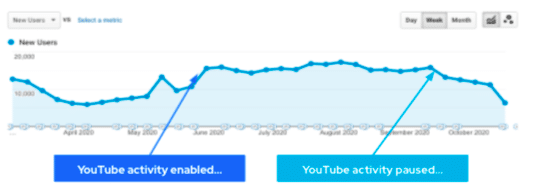
\
And there you have it, that’s how to set up and report on a full funnel strategy from start to finish, the audiences, bidding and format that need to be used for each section. Please feel free to email me over any questions, or to have a chat about anything YouTube.
Greg Holland, Impression | gregory.holland@impressiondigital.com

